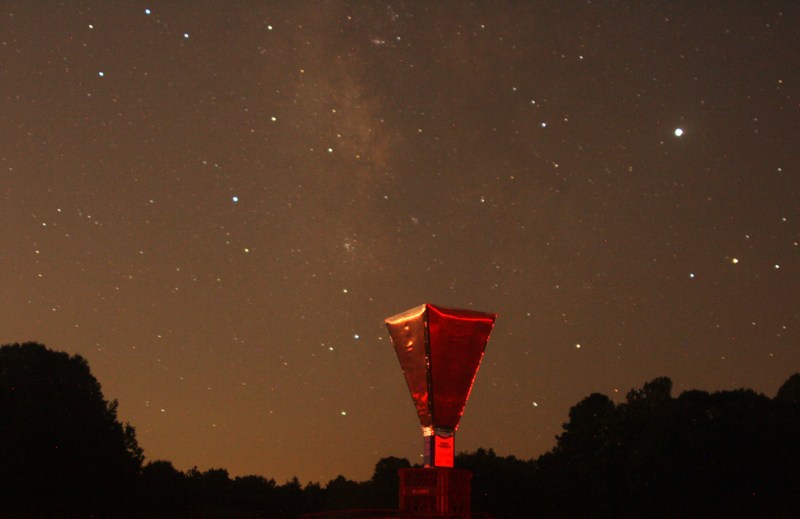[David Schneider] asked himself, “How big a radio antenna would you need to observe anything interesting?” The answer turns out to be a $150 build of a half meter antenna. He uses it to detect the motions of the spiral arms of the Milky Way. The first attempt was a satellite TV dish and a cantenna feed, which didn’t work as the can wasn’t big enough to pick up signals at the 21cm wavelength of hydrogen emissions. Interstellar gas clouds are known to emit radio energy at this frequency.
Looking online, [David] tried aluminized foam board insulation, but was worried that the material didn’t seem to actually be conductive. A quick thrown-together Faraday cage with a cell phone didn’t seem to block any calls. Abandoning that approach, he settled on aluminum flashing used for roofing.
The roll of flashing was ten feet long and 20 inches wide, so that limited the antenna’s design. Still, an online calculator showed a theoretical gain of 17dB. A can still shows up in the final build — a paint thinner can.
There was a time when picking a receiver for a project such as this would be a challenge. Nowadays you can just pick up an RTL-SDR and you are good to go. The setup is sensitive enough to pick up the frequency of gas clouds and detect the Doppler shift between the arms heading towards us and those traveling away from us.
Depending on your goals, you can use a TV dish for radio astronomy work. Probably none of these will pick up what the Chinese can hear with their new 500 meter installation.
















It’s possible that the aluminized foam board didn’t make a good faraday cage because the panels were not electrically connected. The oxide layer on the aluminum, or any protective coating on it, would prevent good electrical contact and could form a slot antenna.
I’m really confused about those faraday cages (at high frequencies?)
Some 20 years ago I did a simple experiment with a GSM phone.
I put it in a metal (steel) cookie jar and closed the (also steel) lid and then called that phone from another phone, and it rang.
It seems that faraday cages have to be grounded to be effective, or else signals are re-transmitted on the other side and it seems that the wall of the cage is just some kind of capacitor.
But how to make an effective GND connection for the frequencies of interest?
No. See the wiki page (do not agree with the way it is written, but is generally correct)
https://en.wikipedia.org/wiki/Faraday_cage
Note skin depth vs frequencies vs material.
So, is there a place on the web where home radio astronomers can submit their readings?
Wondering if not, I’d check with SARA first (http://www.radio-astronomy.org/), if the SATNOG’s open source model would be a way to start if there isn’t another model to get the ball rolling. https://en.wikipedia.org/wiki/SatNOGS
SETI you’d think would… though I’m not sure since haven’t looked at in over 20yrs and there was BAMBI. https://en.wikipedia.org/wiki/Search_for_extraterrestrial_intelligence
http://www.bambi.net/
Here are some other links also:
https://www.nrao.edu/epo/amateur/ (NRAO might know resource also)
https://nightsky.jpl.nasa.gov/event-view.cfm?Event_ID=56649 (JPL might know resource also)
Prior Hackaday articles with dependable’s that might know also:
https://hackaday.com/2019/01/20/radio-telescopes-horn-in-with-gnu-radio/
https://hackaday.com/2018/10/13/tiny-telescope-for-simple-radio-astronomy/
https://hackaday.com/tag/radio-telescope/ (Seems there was a recent article also that isn’t noted that had great open source info and a detailed Reddit post)
Here’s the other article I was thinking about: https://hackaday.com/2019/09/29/probe-the-galaxy-on-a-shoestring-with-this-diy-hydrogen-line-telescope/